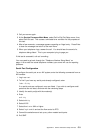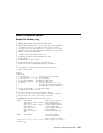
With the remote terminal connected to serial port 1 and defined as the primary
console device, there are two tests you can perform:
1. Will the modem drop the connection after the "System initialization complete"
message appears at the remote terminal?
If yes, this is the correct response. The modem is set up correctly.
If no, try another &Dn setting for your server's modem. See your modem manual
for this information. The &Dn command appears in three places each in three of
the sample modem configuration files
2
.
2. Will the server's modem disconnect when the power drops? You can make this
observation at the remote terminal by commanding your server to shutdown and
power off. (The AIX command shutdown -F will do this.) Watch for the message
NO CARRIER on your remote terminal.
If yes, this is the correct response. The modem is set up correctly.
If no, try another &Dn setting for your server's modem. See your model manual
for this information. The &Dn command appears in three places each in three of
the sample modem configuration files
2
.
Recovery Strategy
The recovery strategy consists of making two calls to establish a remote session.
This is the easiest solution to implement, and allows more freedom for configuring
your server's serial ports.
To set up a remote terminal session, dial into the Service Processor and start the
system. After the operating system is loaded and initialized, the connection will be
dropped. At this point, you call the server back and the operating system will answer
and offer you the login prompt.
2
Only the following sample modem configuration files contain the &Dn command (in three places each):
modem_f.cfg
modem_f0.cfg
modem_f1.cfg
If you are using modem_z.cfg or modem_z0.cfg, you cannot control DTR response. If your remote
terminal does not disconnect after logging off, you must command the remote terminal emulator to hang
up. This then breaks the connection.
Appendix D. Modem Configurations D-7


















